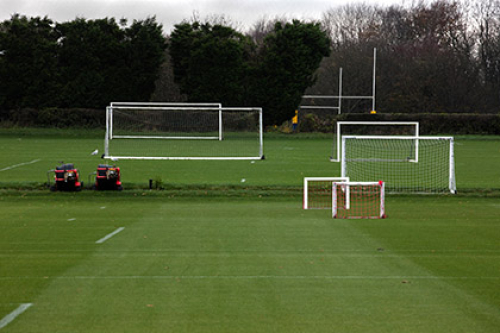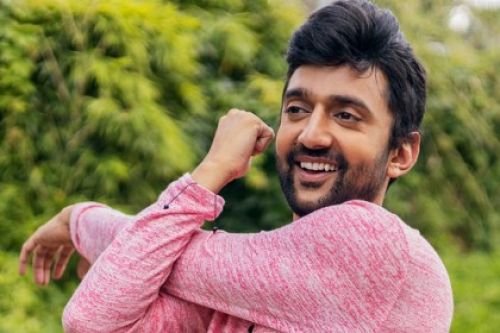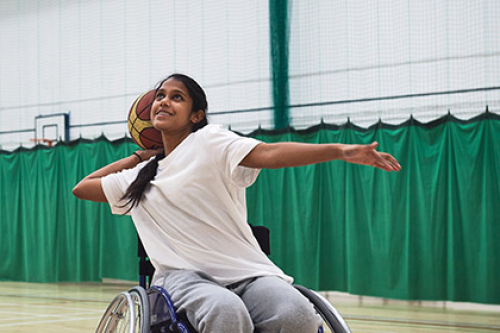The video starts with a slow-motion pan across the front of Leys Pools and Leisure Centre, with an upbeat music track in the background.
Pull-up banners promoting Active Oxfordshire and Sport England are shown inside the building; they feature the words ‘fighting inactivity, tackling inequality’, ‘making places active together’ and ‘move together’.
We then hear the voice of Lisa Dodd-Mayne, Sport England’s executive director of place, before she’s shown speaking in the leisure centre.
Lisa says: “We’re in Blackbird Leys, one of the priority areas that Active Oxfordshire are working in as part of our Place Universal Offer.”
People sit in rows watching someone presenting in a room in the leisure centre.
Lisa says: “The universal offer is part of our place-based work and our place-based approach.”
A woman films the presentation on her mobile phone, before we see shots of people talking at the same meeting.
Lisa says: “It's very much based on the principles of proportionate universalism, which basically talks about that everybody across the country needs some help and some support, but then we invest more deeply, more heavily in those places that need it most.”
Becca Higgs, Sport England’s place universal lead, talks in front of the leisure centre.
Becca says: “The reason that we've invested in places like this is to tackle inactivity, make more people active and get more people moving.”
People stand in small groups talking in a room.
Adam Rigalsford, Sport England’s director of place relationships, talks inside the leisure centre, with a sports hall below him in the background.
Adam says: “We want to tackle inactivity across the county. So we're funding Active Oxfordshire to work with places, with community organisations, with health, with transport and other partners to tackle some of the root causes of that.”
A group of people wearing Active Oxfordshire polo shirts stand talking.
Josh Lenthall, Active Oxfordshire’s chief executive, talks from the same balcony above the sports hall.
Josh says: “We're putting the money, the support, the energy right where it's needed in Oxfordshire’s 10 most priority wards.”
A woman in a white jacket talks to a group of people outside a school playground.
Josh says: “And what that's allowing us to do is start to turn the needle on inequality.
“We've had guests coming from across the region and nationally, in fact, to see the place-based working that is going on here in Blackbird Leys, seeing where there is power being placed right in the hands of the community to drive the work against inequality locally.”
The same woman addresses people stood in a semi-circle in a school hall, with a presentation on a TV behind her, and Lisa is shown talking at the same gathering.
Returning to the leisure centre balcony, Lisa says: “As part of our Uniting the Movement strategy we want more people to be active. My great ambition is that there isn't a gap where you live in terms of your opportunity to be active.
“So we're delivering on what we said we would deliver in a mixture through deepening the work that we started in 2018 through our original pilots, expanding out into another up to 80 places and then our Place Universal Offer alongside that, which means that everybody has the opportunity to share the learning to understand what we mean by place-based working.”
Towards the end of Lisa’s last sentence, we switch to a shot of the woman in the white jacket holding a mobile phone and talking in the school; there are drawings of butterflies behind her and we then see these being coloured in by people sat at a table.
We see a wall painted with colourful drawings of people next to a staircase in the school. On three separate stairs, the words ‘be kind, be safe, be ready’ are written in different colours.
There’s another wall painted with a scene describing the joy of books and reading.
Outside the leisure centre, Becca says: “We’re in the early days for the Place Universal Offer and it's in its infancy, but it's really starting to build momentum.
“It's starting to connect the dots within communities and they're starting to make an impact, and we're seeing inroads into how communities are getting active and getting moving through the Place Universal Offer.”
The video ends with an aerial shot of Leys Pools and Leisure Centre and then some football pitches next to it; Sport England’s logo is overlaid.







